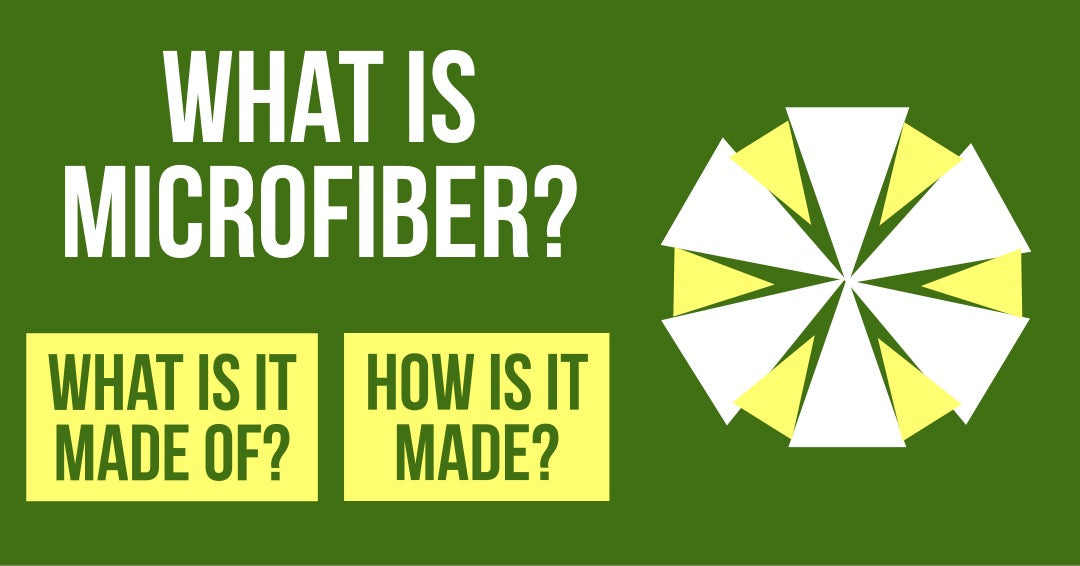
What is Microfiber?
Microfiber is any fiber that is less than 1 denier, and there are several different types of microfiber towels.
One denier is 10 micrometers in diameter. A strand of silk is one denier. A human hair is 5 denier.
What is it made out of?
Microfiber is usually made of polyester, polyamide (nylon), or a blend of the two.
Typical Blends of Microfiber (Polyester/Polyamide):
- 100% Polyester
- 85/15
- 80/20
- 75/25
- 70/30
How is Microfiber Made?
- Fibers are pulled from raw polymers (polyester and polyamide)
- Yarn is spun in a blend
- Fabric is Woven or Knit
- Material is Dyed and Split
- Fabric is Cut and Sewn
- Finish Product Constructed
About Microfiber Yarn
Filaments of polyester and polyamide are drawn from the raw polymers. The filaments are spun together in a blended yarn, at a specific ratio (see above).
The filaments can be drawn in a wide variety of denier (similar to diameter). Finer yarns are more difficult to make consistently, so they are more expensive.
Yarn becomes Fabric
Microfiber yarn is woven or knit, on machines, into large bolts of fabric.
There are many different types of machines that create different “weaves”, which excel at different types of cleaning.
Weave Types include:
- Terry
- Waffle
- Suede
- Two-Pile
- Plush (High Pile)
- Twist
- Pearly
- Diamond
Microfiber fabric is made to a target GSM (grams per square meter) specification. Which is the fabric weight.
GSMs range from 200 all the way up to 1200. The most common GSM is 300gsm.
The pre-dye and pre-split fabric is often called “gray material”.
Fabric is Split
Microfiber fabrics made for cleaning are “split” in the dyeing process, at a separate factory called a dye-house. These factories specialize in dyeing all different types of fabric.
The fabric is placed in a giant vat and it is exposed to a chemical agent that breaks down the fiber polymers in a controlled manner. The chemical breakdown of the fibers creates microscopic “pours” in the fibers making them absorbent, and creating their “static-like” attraction to dirt and dust.
Final Product Construction
After the dyeing and splitting process the fabric is taken to a separate factory where it is “cut and sewn”. The material is cut into different patterns; various fabrics are combined and seen into finished products.
The fabric is constructed into:
- Towels
- Mitts
- Sponges
- Tools
- Pads
- Aprons
- Bags
History of Microfiber
Synthetic fibers of less than one denier were first made in Japan around 1950. In the 1990’s microfiber cleaning products began becoming popular in Europe, and were being made primarily in stand alone factories in South Korea.
In the late 90’s American companies began to import and market microfiber cleaning products to auto enthusiasts and auto detailers. It took a long time for microfiber cleaning products to catch on in the United States, but auto detailers were early adopters.
In the early 2000s Korean microfiber manufacturers began moving production to China to reduce labor costs. This allowed the price to drop significantly and helped with widespread adoption. Now 90% of microfiber cleaning products are made in China.
Now the microfiber manufacturing process is fully distributed between multiple factories. Microfiber yarns are made at a company specializing in that process. The fabric is knit at knitting factories, the material is dyed and split at a dye-house. It is cut and sewn into finished products at a finishing factory.
Learn about the History of Autofiber in the Microfiber Industry.


Leave a comment